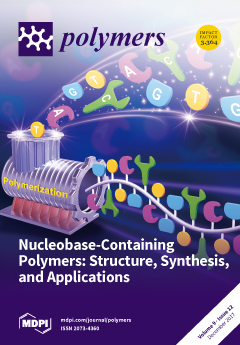This work is focused on the structural and morphological investigations of polyaniline and poly(
o-anisidine) polymers generated in a direct current glow discharge plasma, in the vapors of the monomers, without a buffer gas, using an oblique angle-positioned substrate configuration. By atomic
[...] Read more.
This work is focused on the structural and morphological investigations of polyaniline and poly(
o-anisidine) polymers generated in a direct current glow discharge plasma, in the vapors of the monomers, without a buffer gas, using an oblique angle-positioned substrate configuration. By atomic force microscopy and scanning electron microscopy we identified the formation of worm-like interlinked structures on the surface of the polyaniline layers, the layers being compact in the bulk. The poly(
o-anisidine) layers are flat with no kind of structures on their surfaces. By Fourier transform infrared spectroscopy we identified the main IR bands characteristic of polyaniline and poly(
o-anisidine), confirming that the polyaniline chemical structure is in the emeraldine form. The IR band from 1070 cm
−1 was attributed to the emeraldine salt form of polyaniline as an indication of its doping with H
+. The appearance of the IR band at 1155 cm
−1 also indicates the conducting protonated of polyaniline. The X-ray diffraction revealed the formation of crystalline domains embedded in an amorphous matrix within the polyaniline layers. The interchain separation length of 3.59 Å is also an indicator of the conductive character of the polymers. The X-ray diffraction pattern of poly(
o-anisidine) highlights the semi-crystalline nature of the layers. The electrical conductivities of polyaniline and poly(
o-anisidine) layers and their dependence with temperature are also investigated.
Full article






